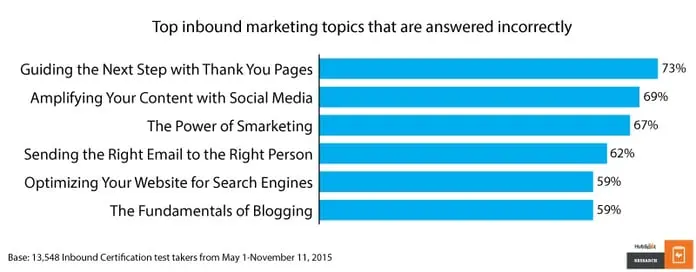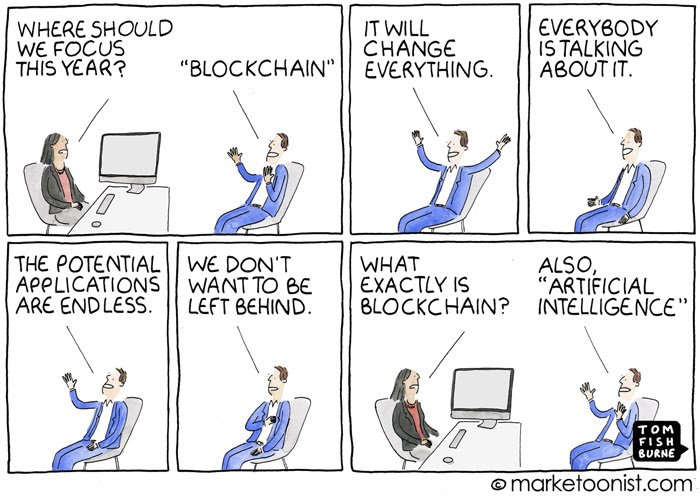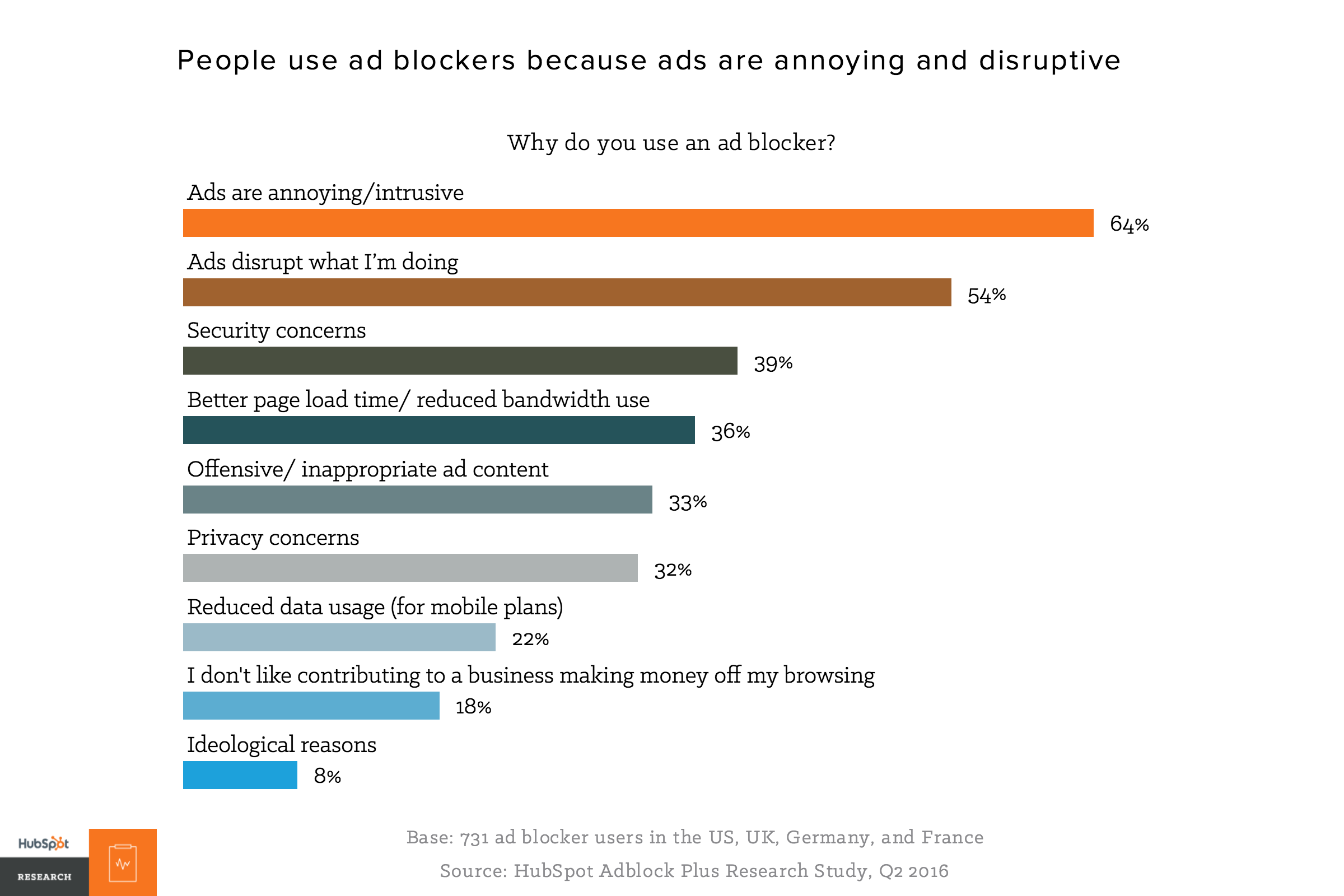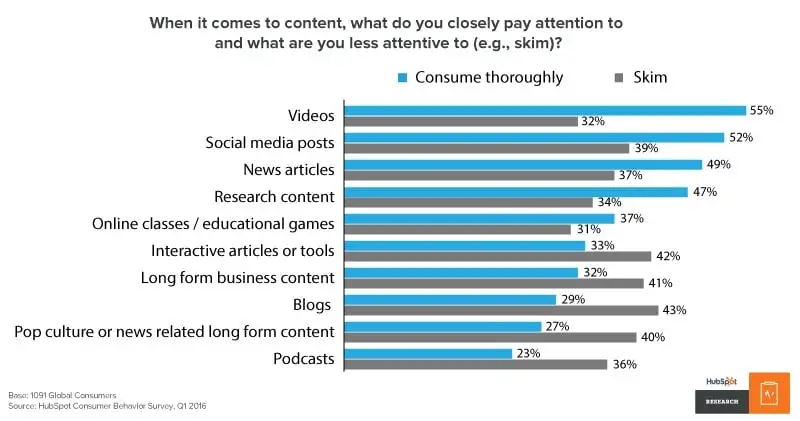Twenty-four percent of marketing teams state that training is a top challenge for their team.1 Given all the channels marketers must engage in to connect with their audience and generate leads, mastering every marketing tactic proves to be difficult. Lean marketing teams must run SEO for their webpages, launch multichannel campaigns, facilitate social engagement, conduct lead nurturing and scoring, hit their numbers, and hand off marketing qualified leads to sales. Within each marketing element, there are countless nitty gritty tasks a marketer must be aware of. Understandably, some things fall through the cracks. So how can marketing managers help their team stay on top of their game?
HubSpot recently compiled the questions marketers miss the most from our Inbound Marketing Certification test2 and categorized the sections that prove to be most difficult. For marketing leaders planning their training curriculum, this is what over 13,000 inbound marketers around the world are having the most trouble with:
-
The entire marketing team must understand their relationship with sales, especially at the bottom of the funnel.
-
The tenets of social media amplification.
-
Refreshers on email targeting, search engine optimization (SEO), and blogging.
Figure 1: Where marketers struggle 
Table of Contents (11 min read)
- The Difficult Concepts: 'Smarketing' and Making Sense of Social
- The Basics: Email Marketing, SEO, and Blogging
- Closing Thoughts: Q&A With HubSpot's VP of Marketing
THE DIFFICULT CONCEPTS: ‘Smarketing’ and Making Sense of Social
The Sales Conundrum
Misalignment between marketing and sales is a common issue across many organizations. But getting this alignment right creates serious upside on the bottom line. According to a study by the Aberdeen Group, companies with strong marketing and sales alignment hit twenty percent annual revenue growth. Compare that to companies with poor ‘smarketing’ alignment, which saw revenues decline by four percent.3
It is important for rank-and-file marketers to understand the tenets of ‘smarketing’: marketing and sales align their activities and goals to create a more effective sales funnel. Marketing feeds sales leads, using agreed upon metrics and lead qualifications, and Sales agrees to work accepted leads so that they become customers (see Figure 2). A tight relationship between marketing and sales means that the leads marketing works so hard to generate get worked. Click to tweet
The questions that proved most difficult for marketers were ones around nurturing an opportunity after they have converted on a piece of content. Marketers are not sure what the next steps are to turn their lead into a viable opportunity for sales.
Tackling this uncertainty will require managers to clearly outline the smarketing process for their organization.
Figure 2: A unified sales funnel, fed by leads generated from marketing 
It’s one thing to communicate the importance of smarketing, but the real onus is on marketing and sales management to forge the marketing-sales relationship. Smarketing needs to be embraced at the top for it to be effective. As a marketing leader, ensure that the following are clearly defined and acknowledged by marketing and sales in your organization:
- Marketing metrics are aligned with sales needs
- Sales revenue numbers created with input from marketing
- Ensure the number of leads marketing is responsible for generating reflect sales quota and revenue goals
- Define attributes of marketing qualified leads and sales qualified leads
- Create a playbook on how marketing nurtures opportunities. For example, once a lead is labeled as an opportunity, should marketing stop emailing promotions? Move them to a different email list? Or send them only ‘nurturing’ content to convert them into a customer?
- After a lead turns into a customer, sales works with marketing to ensure they have a ‘delightful’ customer-vendor relationship.
- Marketing can track the revenue they contributed through closed loop feedback and analytics (see Figure 3).
- Sales and marketing teams meet regularly to discuss past wins, goal attainment, and future plans.
If these items haven’t been established, it will be difficult for marketers to know what steps to take to nurture their leads or work with sales. If your organization already has these metrics and playbooks ready, educate your marketers on how they can achieve the goals established.
Figure 3: Closed loop marketing model 
! For more information, check out HubSpot’s Power of Smarketing slideshare on creating a smarketing plan.
Proving Social Media’s Value
Proving ROI is a top preoccupation for marketing leaders. For too long, marketing has been seen as a cost center that spends budget with very few measurable returns to a business’ bottom line. ![]() Click to tweet In fact, proving ROI was the top challenge cited by marketers globally in the 2015 State of Inbound Report. (As a sidenote, effective smarketing can do a lot to combat that image of marketing).
Click to tweet In fact, proving ROI was the top challenge cited by marketers globally in the 2015 State of Inbound Report. (As a sidenote, effective smarketing can do a lot to combat that image of marketing).
Now let’s focus just on social media, an unwieldy marketing channel whose efficacy is notoriously difficult to track.
Social media has blown up a lot of marketer’s day jobs. New positions like ‘social media manager’ and ‘community manager’ have cropped up in recent years and are now critical components of marketing teams. It’s well known that customers today engage with brands on multiple channels, especially on social during the discovery and consideration phases of the buying cycle (see Figure 4).4 However, marketers have always had a hard time finding the most efficient and effective ways to use social in their campaigns. Further, measurement for social tends to be tricky because few have figured out how to track back social media efforts into a specific lead or revenue number. As a result, many marketers are saddled with uncertainty as they pursue social -- they know it’s necessary, but can’t prove its efficacy. Additionally, to complicate things further, there’s also a lot of uncertainty on what networks to leverage for what type of content. When creating a social media training course, take time to talk about testing channels and metrics with your marketers.
Figure 4: Forrester’s Web of Channels that Consumers Leverage During the Buyer’s Journey 
Source: Forrester Research Blog
Q&A WITH HUBSPOT’S SOCIAL MEDIA MANAGER
 Chelsea Hunersen, HubSpot’s social media manager, shares her approach to social. Thanks to Chelsea, HubSpot has over 600,000 followers on Twitter, 880,000 Facebook friends, 126,000 LinkedIn followers, and 25,000 Instagram followers.
Chelsea Hunersen, HubSpot’s social media manager, shares her approach to social. Thanks to Chelsea, HubSpot has over 600,000 followers on Twitter, 880,000 Facebook friends, 126,000 LinkedIn followers, and 25,000 Instagram followers.
How can a manager set up social media marketers for success?
Understand that social is different. It can be viewed as a marketing platform, service, PR, or a content platform -- if you do a good job, it will be all of them. It’s a one-to-many as well as a one-to-one communication system. So you have to do both to be successful. And to be successful, you need to understand your community, and how social metrics and influence works. Also, social changes a lot -- be open to the fact that what works today may not work tomorrow. Building a successful social channel also takes time.
Most importantly, remember social is a funky funnel. As marketer’s expand reach, only a few followers will click, and even less will convert. Just because you have the reach doesn’t mean you’ll get leads. Sometimes managers fundamentally misunderstand that -- they think if they just grow reach they’ll get increased leads. That’s not the case.
How did you prioritize which social networks to use?
Our social media effort is measured on lead gen, so everything we do has to result in a lead. I target networks I know our persona uses. Then I prioritize networks to focus on based on how much time it takes manage and how much return I get from it. I use past campaigns for comparison. For example, if I find that one Facebook post gives more return than I did with 10 tweets, and making that post took less time to craft, or cost less, I’ll favor Facebook.
Sometimes you see some companies completely eliminate a big channel from their social effort because they decide it’s not worth the time and effort. It has to be relatively scalable and worth your time, whatever goal you have.
How do you prove or measure success?
I can get a report of all our leads in HubSpot and see how many of those leads have the original source type of ‘social media’. I can track all the leads my social campaigns generated.
What metrics do you track?
Reach and leads are my two consistent metrics in the last 6 months. What I choose to measure can change over months. I do a lot of experimentation and check the effectiveness of experiments. One mistake social media marketers make is to focus just on stuff they’ve done in the past. Continuously change approaches and try out new channels.
How do you justify spend?
I usually look at the follower-to-lead ratio a channel generates. For $50 on network X, I get 1,000 followers and 10 leads. That means each follower to lead ratio is 1:10. Once you’ve done a few campaigns of various channels, you can compare each channel’s ratio to see which is most effective. Then you calculate the cost of the lead (in this example it costs $5 per lead). I can then go to my manager and say, for this budget, I’m confident I can get 1,000 followers and 10 qualified leads. Each lead will cost me $5. Having hard numbers makes the difference.
What are the questions you get asked about effectively using social?
The most common question is: How can I be successful? I usually tell them that successful campaigns have these components:
1. Create a compelling image, in the right dimensions for the network. Make a tailored image, don’t simply copy a slide and push it to social.
2. Copy should be differentiated and tailored for each social network you use. My goal is to have copy that’s compelling enough to pull someone in and get them to share or retweet. A share tells me they like it enough to spread it to their own network. I recommend people check out HubSpot’s posts on writing trigger words and good headlines for inspiration.
THE BASICS: Email Marketing, SEO, and Blogging
Over half of Inbound Certification test takers missed questions on the core competencies of internet marketers: email marketing, SEO, and blogging basics. ![]() Click to tweet. These modules relate to deeply tactical tasks. Our data shows many teams could benefit from some ‘refresher’ workshops on SEO or email marketing so that any gaps in knowledge can be filled. There’s a wealth of information and training online on email, SEO, and blogging to leverage, so the following points focus on elements HubSpot’s Academy Professors get asked about the most.
Click to tweet. These modules relate to deeply tactical tasks. Our data shows many teams could benefit from some ‘refresher’ workshops on SEO or email marketing so that any gaps in knowledge can be filled. There’s a wealth of information and training online on email, SEO, and blogging to leverage, so the following points focus on elements HubSpot’s Academy Professors get asked about the most.
Email Marketing Challenges: Segmentation and Results
Many marketers are not sure what to send in their emails and who to send to. It’s especially difficult if the only thing they know about a contact is their email address. It’s hard for marketers to send tailored emails when they don’t know anything about the people in their email lists. Asking for some information on top of email -- like company size, job title, or biggest company challenges -- provides some context to tailor future messages to the contact. That way, email will be more clearly integrated into your inbound strategy. The information marketers ask for in forms will directly impact their ability to nurture contacts and close them into customers (see Figure 5).5 Check out HubSpot Academy’s guide on emailing the right person at the right time for a complete action plan.
Figure 5:Common Email Segmentation Levers For Marketers  Source: The Direct Marketing Association
Source: The Direct Marketing Association
In terms of results, too much focus is given to clicks and opens. While clicks and opens are important metrics to consider, they aren’t the primary goal of your email. Businesses send emails to compel action -- to read more, to sign up, to attend. Clicks and opens are just hurdles readers must navigate to reach the final action. Instead, HubSpot Academy recommends focusing on the actions of the email receiver after they click into the email. The ultimate goal is to have the receiver read the email content and click on the CTA.
That means marketers need to ensure they create emails with a single goal and a clear call-to-action. ![]() Click to tweet Then they need to tie the actions they see on a landing page back to the email activities that drove people to the page. Calculate the clickthrough rate and conversion rate generated from email to the landing page.
Click to tweet Then they need to tie the actions they see on a landing page back to the email activities that drove people to the page. Calculate the clickthrough rate and conversion rate generated from email to the landing page.
SEO and Blogging: Focus on the Basics
SEO is complicated and some online how-to’s get very technical about search algorithms. It can be overwhelming. HubSpot often hears comments like “I know I should do SEO, but I don’t know where to start.” HubSpot Academy prefers to teach marketers to focus on the basics: Is their web page easy to use? Is their content good? Is there a solid keyword strategy?
People tend to have trouble doing keyword research. Often, they just start blogging and don’t really get the results they’re seeking.
How can marketers find the right keywords to rank for? Generally, don’t aim for broad keywords. A local toy store would have a hard time ranking for a generic keyword like “toy store”, but it could rank number one for “mom and pop toy store in Toronto.”
It all comes down to what differentiates your organization. Is your business local? Do you brand yourself as a mom and pop shop? Who are your personas? Are you selling to particular industries? Blog about those differentiators.
People also struggle to keep up with the newest developments in SEO (and by extension, blogging). As search algorithms get smarter and smarter, search engines seek out ‘good’ content rather than a simply counting keywords on a page.
To address this, marketers still need a keyword strategy -- it’s the best way to find the right topics to write about. But when it comes to writing that content, don’t just stuff the post full of one keyword. Marketers need to put more content into their content: Don’t be afraid to go on tangents or talk about related things to your core topic in one big post. At the end of the day, search engines and readers will reward quality over quantity. It may be an investment in time initially, but blog posts can generate a huge amount of compounding traffic over time while increasing your website’s SEO rank. Have your team check out these checklists that cover strategies for blog optimization and brainstorming blog topics.
! For more information, check out HubSpot Academy’s checklists, which walk through the steps to optimize your website for local SEO and on-page SEO.
CLOSING THOUGHTS: Q&A With HubSpot's VP of Marketing
 Meghan Keaney Anderson shares her views on training and growing her team. Meghan leads the content, product marketing, and customer marketing teams for HubSpot. Together with her teams, she’s responsible for the company’s blogs, podcast, and overall content strategy as well as the company’s product launch and customer demand campaigns.
Meghan Keaney Anderson shares her views on training and growing her team. Meghan leads the content, product marketing, and customer marketing teams for HubSpot. Together with her teams, she’s responsible for the company’s blogs, podcast, and overall content strategy as well as the company’s product launch and customer demand campaigns.
How do managers prefer their employees get trained?
When I think back at my own career -- the most valuable lessons were learned in action. By working through real problems or opportunities you get out of generalizations and into something more lasting. That said, formal training gives you the framework to better navigate those situations. So the ideal learning environment is one that is rich in training, but also intentionally creates experiences designed to stretch employees.
If someone wants to learn more, what’s the usual process you take to help them learn?
Whenever possible, I’ll try to find someone a training program and create a practical opportunity for them to practice what they’re trying to learn. If no training opportunities exist, I’ll personally set aside some time each week or month to work with them on it.
If you found out someone was struggling with something, how do you approach it?
First, the person has to know they’re struggling with something. That’s important to establish. If they don’t recognize it, they won’t begin to address it. Second, they have to understand that whatever it is, it’s temporary. It can be worked through. Getting those two things out of the way are important. From there, it’s just a matter of determining the steps to overcome it.
Do you plan out how to grow the skills in your team? Or is it more ad hoc?
We plan for milestones. We know that certain periods and situations will always stretch a person and we position training against those. Becoming a manager for the first time is a great example, as is tackling a cross-departmental project. A good manager will then supplement these general milestones with personal attention and ad hoc training as it is needed for each member of her or his team.
Why do you think marketing teams struggle with training in general?
The obvious reason that teams struggle with training is that it’s time consuming. I think there’s a perception that training has to be done outside of the day-to-day work of an employee. That the employee has to put work on pause to train. And certainly there are some trainings that require that, but many -- arguably most -- can augment work and be run through it. Training in context is always the best option.
Endnotes
1 See HubSpot’s State of Inbound 2015 report: www.StateofInbound.com
2 Data from the first attempt of 13,548 Inbound Certification test takers from May 1 to November 11, 2015
3 Houpis, Chris. “Sales and Marketing Alignment: Collaboration + Cooperation = Peak Performance.” September 2010. Aberdeen Group.
4 Wizdo, Lori. “Myth Busting 101: Insights Into The B2B Buyer Journey.” Web blog post. Forrester Research Blogs. 25 May 2015. Web. 22. Nov. 2015.
5 van Rijn, Jordie. “National Client Email Report 2015.” The Direct Marketing Association (UK) LTD. 2015. Web. 15. Dec. 2015.



![How AI Perceptions Have Changed in the Last Decade [Comparing New & Old Consumer Data]](https://53.fs1.hubspotusercontent-na1.net/hubfs/53/artificial-intelligence-is-here_3.webp)




